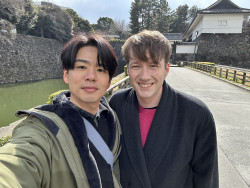
January 15, 2009
Red Star Rising
With global Capitalism on the ropes, local Communism is on the rise
By Metropolis
In 2009, the LDP-Komeito coalition government of Prime Minister Taro Aso will have to call a general election. With the economic situation shaky, the opposition Democratic Party of Japan, led by Ichiro Ozawa, looks set to win. But for Shii, the two main parties are almost identical in terms of economic outlook and their views of Japan’s continuing relationship with America. The fact that Ozawa used to be Secretary General of the LDP before joining the DPJ has strengthened this perception among voters who are increasingly cynical about the main parties.
“The people are disillusioned by the LDP and the Democratic Party of Japan,” Shii says. “A public opinion poll recently showed a very interesting result. When asked who would be a better Prime Minister, Ozawa or Aso, Ozawa narrowly won. But a majority of the respondents also said that neither of them is appropriate. People are beginning to realize that it isn’t enough to change the face on the package, you have to change the contents of government as well.”
Although economic times are hard, conditions are far from being as bad as they were on Kobayashi’s fictitious factory ships in the waters off Siberia. Nevertheless, Japan’s export-geared economy, dominated by large corporations keen to retain competiveness by squeezing labor, supported by a political system that relies heavily on big business contributions, is creating the dissatisfaction needed to fuel political change. Although the Communists are unlikely to win power anytime soon, under the leadership of Kazuo Shii, they seem set to make impressive gains in 2009.
The Alternative Economy
Not all economic activity has to be driven by financial gain. Even in an intensely capitalist system like Japan’s, there are parts of the economy that exist beyond the profit principle, founded instead on ethics of public service and mutual social benefit. With companies finding it increasingly difficult to enlarge on investment in the current recession, Japan’s alternative economy provides an interesting picture of economic survival in a post-profit world.
Co-ops
Consumer cooperatives provide products and service for their members and other consumers, with all proceeds either re-invested in improvements or passed on to members and consumers in the form of price reductions or refunds. Japan has a large co-op movement, with 30 percent of all households belonging to one. The Japanese Consumers’ Cooperative Union, established in 1951, represents a wide variety of organizations, including retail, medical, housing, and insurance co-ops. In fiscal 2005-2006, the total turnover of JCCU affiliated co-ops was in excess of ¥307 billion, and Co-op Kobe alone boasts some 1.2 million members. www.jccu.coop/English_here/aboutus
Fureai Kippu
Translated as “Caring Relationship Tickets,” this scheme was created in 1995 as a means of getting young people to volunteer to assist the elderly or the infirmed. In return for providing transportation, cooking or cleaning, and companionship, the helpers receive credits that they can then use when they become old or infirm themselves. This provides a system of care that is equally independent of the tax-fueled public sector and the profit-driven private sector. The fact that those giving care earn credits that will enable them to receive help also facilitates a deeper sense of sympathy and understanding between those who help and are helped. www.sawayakazaidan.or.jp/english/index.html
Eco Money & Local Currencies
Partly based on the Fureai system, a number of townships in Japan have created local currencies to stimulate useful interaction between citizens. In 1999, the town of Kusatsu in Shiga Prefecture issued a local currency called the “ohmi” after the region’s Edo period name. This move has been emulated by more than 30 communities, who use the money to reward people for cleaning up garbage, improving the environment, and repairing objects rather than throwing them away. In the town of Kuriyama in Hokkaido, a man earned 3,000 “kurins” for fixing the handrail of a staircase in a neighbor’s house. He then used 1,000 kurins to pay someone to fix his daughter’s toy, while another 1,000 were given to an old man in return for writing addresses on postcards using traditional Japanese calligraphy.
Communes
Communes are communities where the profit motivation of the individual is merged in the shared economic interests of a group. Due to zany or dangerous commune-based religious cults like Panawave and Aum Shinrikyo, communes in Japan tend to have a negative image. Perhaps the best-known commune movement is that founded in 1956 by a chicken farmer named Miyozo Yamagishi. Today there are 32 Yamagishi communes with approximately 1,200 members. People wishing to escape the rat race donate their property to the commune then live and work in one of several farms run by the group. Another feature of the commune is that children over the age of 6 move into dormitories instead of staying with their parents. www.yamagishi.or.jp
NPO Banks
Japan is a nation of savers, but according to Masaki Kimura, a director of the community youth bank Momo, conventional banks tend to draw savings from regional areas and concentrate investments in Tokyo. “This indicates that money in the countryside is siphoned by Tokyo: local money does not flow in the region,” he says. To counteract this trend, NPO banks seek to localize finance while targeting it on activities that will have the maximum positive impact rather than profit. For example, the bank has invested in green tourism and organic farming by city dwellers and students keen to experience traditional rural lifestyles. Japan has nine NPO banks that have to date lent about ¥1.7 billion, with far better results than profit-driven banks like Lehman Brothers and HBOS. www.momobank.net; www.japanfs.org/en_/college








